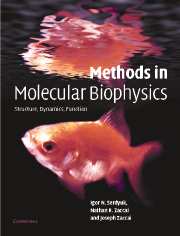Book contents
- Frontmatter
- Contents
- Foreword by D. M. Engelman
- Foreword by Pierre Joliot
- Preface
- Introduction: Molecular biophysics at the beginning of the twenty-first century: from ensemble measurements to single-molecule detection
- Part A Biological macromolecules and physical tools
- Chapter A1 Macromolecules in their environment
- Chapter A2 Macromolecules as physical particles
- Chapter A3 Understanding macromolecular structures
- Part B Mass spectrometry
- Part C Thermodynamics
- Part D Hydrodynamics
- Part E Optical spectroscopy
- Part F Optical microscopy
- Part G X-ray and neutron diffraction
- Part H Electron diffraction
- Part I Molecular dynamics
- Part J Nuclear magnetic resonance
- References
- Index of eminent scientists
- Subject Index
- References
Chapter A2 - Macromolecules as physical particles
from Part A - Biological macromolecules and physical tools
Published online by Cambridge University Press: 05 November 2012
- Frontmatter
- Contents
- Foreword by D. M. Engelman
- Foreword by Pierre Joliot
- Preface
- Introduction: Molecular biophysics at the beginning of the twenty-first century: from ensemble measurements to single-molecule detection
- Part A Biological macromolecules and physical tools
- Chapter A1 Macromolecules in their environment
- Chapter A2 Macromolecules as physical particles
- Chapter A3 Understanding macromolecular structures
- Part B Mass spectrometry
- Part C Thermodynamics
- Part D Hydrodynamics
- Part E Optical spectroscopy
- Part F Optical microscopy
- Part G X-ray and neutron diffraction
- Part H Electron diffraction
- Part I Molecular dynamics
- Part J Nuclear magnetic resonance
- References
- Index of eminent scientists
- Subject Index
- References
Summary
Historical review and biological applications
Late 1600s
R. Boyle questioned the extremely practically oriented chemical theory of his day and taught that the proper task of chemistry was to determine the composition of substances.
1750
A.-L. Lavoisier studied oxidation, and correctly understood the process. He demonstrated the quantitative similarity between chemical oxidation and respiration in animals. He is considered the father of modern chemistry.
Late 1700s
The work of J. Priestley, J. Ingenhousz and J. Senebier established that photosynthesis is essentially the reverse of respiration.
1800s
The development of organic chemistry, despite the strong opposition of vitalists (who believed that transformations of substances in living organisms did not obey the rules of chemistry or physics but those of a vital force), led to the birth of biochemistry. In 1828, F. Wöhler performed the first laboratory synthesis of an organic molecule, urea. During the 1840s J. V. Liebig established a firm basis for the study of organic chemistry and described the great chemical cycles in Nature. In 1869 a substance isolated from the nuclei of pus cells was named nucleic acid. O. Avery's experiments of 1944 on the transformation of pneumococcus strongly suggested that nucleic acid was the support of genetic information.
1860s
L. Pasteur is considered the father of bacteriology. He proved that microorganisms caused fermentation, putrefaction and infectious disease, and developed chemical methods for their study. In 1877 Pasteur's ‘ferments’ were named enzymes (from the Greek en ‘in’ and zyme ‘leaven or yeast’.
Information
- Type
- Chapter
- Information
- Methods in Molecular BiophysicsStructure, Dynamics, Function, pp. 38 - 64Publisher: Cambridge University PressPrint publication year: 2007
